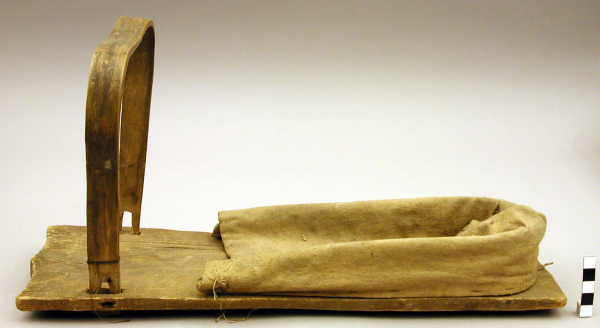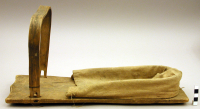tikinaagan
tikinaagan
tikinaagan


This toy cradleboard is a rectangular wooden plank with curved crossbar, and fabric used to secure the doll in place.
The Peabody Museum of Archaeology and Ethnology: Garden River Reserve
The Peabody Museum of Archaeology and Ethnology
Read More About This Relative
wood, cotton, animal hide
To make a cradleboard: First, the artist splits the cedar wood into a flat board using wedges. Cedar strips can be peeled from the log in the same manner. Secondly, the strips are soaked in hot water and steamed to make it easier to bend into the shape a crossbar without breaking. The wet crossbar is secured to a frame to dry in the desired shape. Finally, the crossbar is fastened to the back board.
The Ojibway artist carved a profile on the tikinaagan's headboard that resembles water's waves. The wooden plank has a rectangular shape, and the crossbar is bowed.
The Anishinaabe worldview flows out of the land and the environment. Living in balance with the environment, and others, is to live a good life (mino-bimaadiziwin). This worldview is built into the language. The songs, stories, and art present in the language. For instance, the Anishinaabe have a beautiful phrase, Niibi Bimaadiziwin (water is life). The correlation between this phrase and the function of the tikinaagan is that both hold and carry a life-force. Thus, the wavy profile on the tikinaagan's headboard is symbolic.
This cradleboard is a toy. The cradleboard represents the teaching that the child is closest in spirit to the spirit world and the child and spirit world see and hear everything in their view. This cradleboard was presented as a gift and then kept as an example of material culture.
The Peabody Museum of Archaeology and Ethnology
Provenance
Mr. Peter Mahgsanikwe Jones (08/30/1900) was the owner of the cradleboard. Then, in 1901 Theodore Jewett Eastman owned it. In 1938, Mrs. Henry H. Richardson donated the cradleboard in memory of DR. Theodore Jewett Eastman.
The Peabody Museum of Archaeology and Ethnology
About This GRASAC Record











The Peabody Museum of Archaeology and Ethnology
 Knowledge Sharing Platform
Knowledge Sharing Platform

